by Pia Chakraverti-Wuerthwein
“In Search of Maintained Solidarity: A Frame for the No Longer Visible,” January 24–25, 2020, Kunstverein in Hamburg. Curated by Antonia Alampi, in response to Oscar Murillo’s exhibition “Horizontal Darkness in Search of Solidarity”
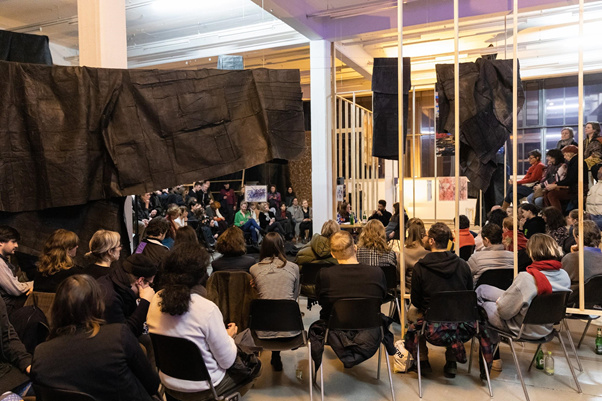
collective conscience (2015–ongoing). Activated in the context of “In Search of Maintained Solidarity: A Frame for the No Longer Visible,” Kunstverein in Hamburg, 2020. Photo: Fred Dott.
Entering the vast hall that forms the first-floor exhibition space of the Kunstverein in Hamburg, one was immediately confronted by Oscar Murrillo’s installation “The Institute of Reconciliation” (2014–ongoing). Massive dark waterfalls extending downwards from the ceiling and black pools huddled on the floor, the fabrics had a physical and olfactory presence of pigment and fire. Murillo’s flight# series—drawings created in the liminal airspace between grounded locations—hung delicately from thin wires while his large-scale “manifestation” paintings and carved windows seemed to watch over visitors. In the center of the room stood collective conscience (2015–ongoing), an installation comprising an agora of wooden bleachers as well as two sitting areas with lawn chairs and stuffed-doll effigies observing Murillo’s other artworks. The effigies are inspired by a particular ritual that Murillo is familiar with from growing up in Colombia. In this ritual, effigies are burned as a way to release the energy of the last year as one moves into the next. However, Murillo has sculpted them in diverse uniforms and with distinct personalities. They thus symbolize the working body in a global context, and stand in for the invisible laborer who is otherwise overlooked or erased in institutional settings, but without whom they would not exist.
Being in such close proximity to individual artworks, which were also in conversation with one another, gave one the sense of being within the artworks themselves, rather than within an exhibition. This feeling was compounded by the fact that movement was central to the program—with different contributions taking place in different corners of the exhibition hall.
The decision to activate various parts of the space came from the desire, as Antonia Alampi told me, to give “the audience an active role [of] moving together with the contributors,” and to allow different presentations/performances to establish different levels of proximity and intimacy between audience members themselves and in relation to the contributors.1 It is also a decision that emerges from the acknowledgement that very few people can stay for a seven-hour program, whether due to parental duties, personal stamina, or overall interests, and these shifts within the space allowed members of the audience to come and go without interrupting the proceedings. In addition to thinking about our bodies in terms of movement and freedom to come and go, complimentary food and drink was provided as a gesture of care and hospitality to encourage audience members to stay longer and to draw a broader public who would not have come had it been a dry, academic setting. The food was all prepared by long-term staff at the Kunstverein, including dishes cooked by director Bettina Steinbrügge herself, a particularly relevant gesture vis-á-vis the subject of the program.
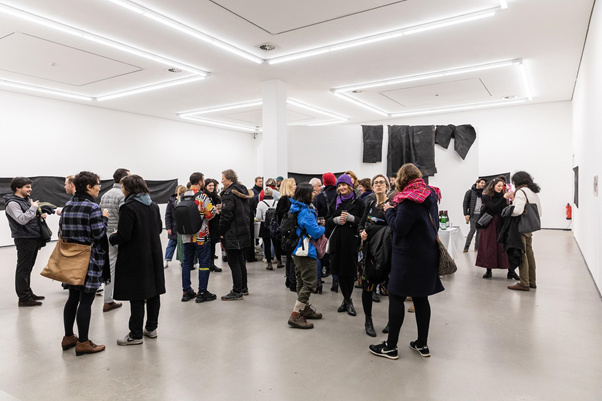
“In Search of Maintained Solidarity: A Frame for the No Longer Visible,” Kunstverein in Hamburg, 2020, Photo: Fred Dott. Over the course of the program, there was a buffet open for participants and the public, where many conversations from the evening continued.
“In Search of Maintained Solidarity: A Frame for the No Longer Visible” was the outcome of a dialogue that started between Clara Dublanc, a close and long-time collaborator of Oscar Murillo for the past seven years in projects such as Frequencies and with a background in political science; Antonia Alampi, curator and artistic codirector of SAVVY Contemporary; and Bettina Steinbrügge, director of Kunstverein in Hamburg. The first evening drew an audience of over three hundred people, far surpassing everyone’s expectations and the norms for discursive programs in Hamburg and elsewhere. The program seemed to sit very comfortably within Murillo’s exhibition architecture and the architecture of the institution.
In her introduction to the program, Alampi highlighted art’s importance as a means of “daydreaming and desiring” within various international solidarity movements including the Bandung Conference and the Museum of Solidarity Salvador Allende. Murillo foregrounded the importance of stepping out of the “comfortable context”2 of the art institution and positioning “hyperlocal and hyper-individual” practices within a “global constellation of strategies.”3 The first day of the program featured curator, researcher, and activist Tanzim Wahab; Liverpool Biennial curator Manuela Moscoso; artist and musician Leyla Yenirce; activist Meike Boldt (Initiative for the Clarification of the Murder of Süleyman Taşköprü); Turner Prize winners Oscar Murillo and Tai Shani; artist and activist Ahmet Öğüt; writer and artist Candice Nembhard; and rapper and musician MC Manmeet Kaur. The second day of the program featured cocurator of the 11th Berlin Biennial María Berríos, artist Jasmina Metwaly, and musician Nadah el Shazly.
Three threads were interwoven throughout the presentations and conversations: solidarity within and beyond the art world, the body as a site of action and trauma, and the role of institutions and informal initiatives in building solidarity.
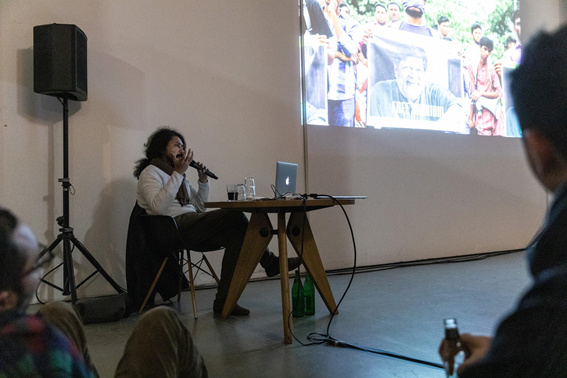
Tanzim Wahab, “In Search of Maintained Solidarity: A Frame for the No Longer Visible,” Kunstverein in Hamburg, 2020, Photo: Fred Dott.
Tanzim Wahab began the program with a lecture on current struggles in Bangladesh, including student protests, which have been brutally repressed, and forced disappearances of art workers and activists. He reminded us that “solidarity is nothing new,” and that there is a long history of connected struggles within South Asia. Wahab cautioned us about overestimating solidarity in the arts, and encouraged us to think, instead, about how to support existing situated movements—like the student protests. Addressing a question about what to do after a concrete action, such as removing a leader or freeing an ally, Wahab emphasized the importance of “mundane” projects that are long-term, and the need to think constructively about one’s public so as to include activists from other fields as well as policymakers.
Solidarity beyond the art world was enacted in the invitation of Meike Boldt, an activist with the Initiative for the Clarification of the Murder of Süleyman Taşköprü. Boldt began her presentation by summarizing the history of Nationalist Socialist Underground attacks on Germans with migrant backgrounds, emphasizing the complicit role the media has played in supporting stereotypes of migrant criminality and aggression. Although there is now far greater visibility of right-extremist terror, and solidarity with its victims, her collective still struggles with the fact that court decisions and laws have not changed along with the public narrative. The questions that she offered us were: How to work continuously as a support group for the victims’ families? How to deal with fatigue and exhaustion? What are the limits of our work?
Jasmina Metwaly, who gave a lecture on her and Philip Rizk’s film Out on the Streets , brought up similar questions about trauma and exhaustion, as did María Berríos. Metwaly mentioned that in spite of all of the first- and second-hand trauma that she experienced while documenting the Egyptian revolution, she didn’t have a way to address it at the time. One of the things she would do differently, she said, would be to make more space for working through feelings and anxiety—something that she now does through body exercises and moving further away from the revolution in her work. In María Berríos’s statement “we are broken, but still fighters,”4 there is another solution: making vulnerability and human fragility central to the struggle. In her presentation of Cecilia Vicuña’s “Palabrarmas” (palabra armas [word weapons] or palabrar más [make more words]), Berríos also mentioned the possibility of solidarity becoming “liquid.”
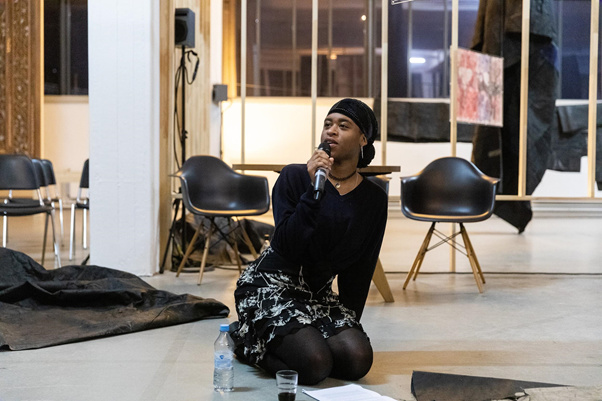
Candice Nembhard performing “The Orator as Non-Mythic,” from “In Search of Maintained Solidarity: A Frame for the No Longer Visible,” Kunstverein in Hamburg, 2020, Photo: Fred Dott.
Liquidity, or fluid identities, was a tool that several practitioners mentioned, including Ahmet Öğüt, in relation to his artwork Silent University , Candice Nembhard in her poem “The Orator as Non-Mythic,” and Manuela Moscoso in her vision of solidarity through the body. For Öğüt, Silent University is an entity that can change depending on the context and the personal and legal needs of the collaborators—allowing those involved to be recognized as members, lecturers, and eventually organizers. In Candice Nembhard’s performance of “The Orator as Non-Mythic,” she presented a figure that exists outside of time and speaks in “A different style of voice that shape-shifts, changing with the tide.”5 Transcendence and constant movement as a means of survival.
Manuela Moscoso introduced her concept of solidarity through the body, drawing attention to how collaboration within the body allows for our existence. She emphasized the fact that 50 percent of our weight is skin, which is “not a frontier, but a passageway.” Building from Brazilian anthropologist Eduardo Viveiros de Castro’s book Cannibal Metaphysics, Moscoso asked that we not run from our enemy, but run towards them and devour their point of view, contaminating them with ours in the process. Identifying one’s enemy was a recommendation that both Wahab and Moscoso made, a rather difficult task in a time when so many toxic and violent things seem interconnected.
In her set, Leyla Yenirce achieved the sort of contamination and cannibalism that Moscoso theorized, digesting fragments of German folk and pop music and spitting them out in aggressive beats and bars. Her set seemed intentionally opaque, with her message communicated through dark beats, crushing bass, and distorted lines about exhaustion and aggression—how to live in a world that systematically seeks to erase you. MC Kaur’s and Nadah el Shazly’s concerts, which closed the program on the first and second days, respectively, were similarly cathartic. MC Kaur was candid and off-the-cuff in a sort of garage-band confessional, complete with freestyles on borrowed beats. On the other hand, Nadah el Shazly channeled Egyptian pop divas of the nineteenth and twentieth centuries, filling the entire hall with her crystalline voice in pared down and experimental renditions of tracks off her debut album, Ahwar.
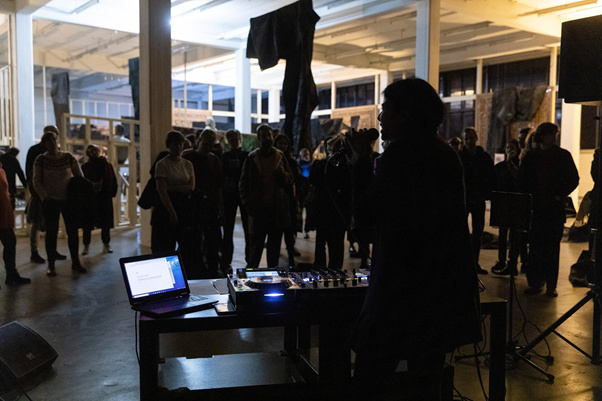
MC Manmeet Kaur. “In Search of Maintained Solidarity: A Frame for the No Longer Visible,” Kunstverein in Hamburg, 2020, Photo: Fred Dott.
Each of the musical performances were staged in a corner of the hall surrounded by pieces of Murillo’s installation The Institute of Reconciliation (2014–ongoing). Alampi decided to stage the concerts there because there were no chairs and so we had to stand and “let [our] bod[ies] be inhabited by the rhythms [we] had in front of [us].”6 While another artist may have feared having so many people so close to his work, Murillo finds a generative antagonism in “using the most revered materials and completely disrespecting them” by letting people walk around and possibly step on the fine linen canvases that make up the installation.7 This antagonistic perspective comes, in part, from Murillo’s acceptance that his work is “never going to glide cleanly within the institutional context” because his very presence, as a racialized working-class artist, discomforts the art elite.8 Rather than accept a marginalized position within the art world, Murillo has established himself as a commercially successful artist and uses his influence to push institutions to work differently.
In his conversation with Tai Shani and Bettina Steinbrügge, he was insistent that we need to go beyond rejecting “dirty” money and be more critical in a way that also challenges the market and major funders. Tanzim Wahab voiced a similar opinion in his lecture when he recommended that artists and curators also bring policymakers into exhibitions, such as the Chobi Mela Photography Festival, where portraits of Rohingya refugees were included, as a means of holding them accountable for the laws they put in place. On the other hand, Tai Shani argued for the need to build solidarity in a way that departs from a heroic narrative of individuals offering solutions to one of contributing to a shared perspective. For her, social media has actually become a productive platform because it erodes authoritative structures, like mainstream media, and has exposed her to strands of feminism and perspectives that she would not otherwise have known.

collective conscience (2015-ongoing) activated in the context of “In Search of Maintained Solidarity: A Frame for the No Longer Visible,” Kunstverein in Hamburg, 2020, Photo: Fred Dott.
Among the practitioners I spoke with about the program and their experience working within this institutional framework, most were positive. One contributor, who preferred not to be named, said they were very happy to be a part of the program and amazed by the performances, but admitted a preference for more community-run spaces. MC Manmeet Kaur, for whom the experience in Hamburg represents a new step in her career, felt very comfortable in the space and found that the experience of performing directly in front of the audience (rather than on a raised stage) gave her the confidence to share some new music. Going forward, she feels inspired to “shift [her own] tonality and opinion, and make [her] music more direct.”
Speaking with Ahmet Öğüt this week, he said that he found it “very different from a conventional symposium” because of the dynamic format, the different public it attracted, and the candid conversations that arose. He found the internal session, which was organized so that contributors could discuss strategies and frustrations in a more intimate setting, particularly productive and was happy that some of the things that came up there also slipped into the public portion of the program. For him, the program was a good step in building “solidarity not only as a political act, but as a counter-financial strategy.” Manuela Moscoso had similar feedback, praising the “great group of people” and “different rhythms” within the program, while also appreciating the internal conversation.
My conversation with Jasmina Metwaly helped me a lot to articulate some of my own ambivalences about the program. She emphasized the fact that the program was very rich in terms of who was invited and how the practices complemented one another. Additionally, she was very happy to attend the performances, each of which she found very moving. However, she did find herself asking the question: Why are we always running out of time? And, urgent as everything feels right now, what about the time we need to be creative, and to just exist as people? How do we balance this push to be productive and present as a coworker, as a comrade, as a parent, with the time we need to recover and to ruminate?
Taken as a whole, “In Search of Maintained Solidarity: A Frame for the No Longer Visible” was an incredibly interesting and intense experience. I am grateful to have been fed with all of the ideas of that weekend and to have made connections that I hope to deepen over time. As I’ve mulled over writing this review, I was hesitant to be simply positive and wasn’t sure why. But the reason is, as good as it was, this program cannot be the end. It was a fantastic opportunity to begin talking about solidarity, but the next step must be enacting it. Solidarity when there is no audience. Solidarity when there is no applause. When nobody is watching and there is no one to tell. What could that look like? I hope the success of the program will encourage art institutions to continue thinking about how existing formats, like exhibitions and discursive programs, can be pushed and complicated into support systems and do-tanks as well as think tanks.
×
NOTES
1 Alampi in a voice message to the author on February 1, 2020.
2 Oscar Murrillo in his spoken introduction to the finissage program on January 24, 2020.
3 Oscar Murillo in a phone conversation with the author on January 31, 2020.
4 María Berríos in her lecture about the Museum of Solidarity Salvador Allende.
5 Candice Nembhard, “The Orator as Non-Mythic” as performed on January 24, 2020.
6 Alampi in a voice message to author on February 1, 2020.
7 Murillo in a telephone conversation with the author, January 31, 2020.
8 Ibid.